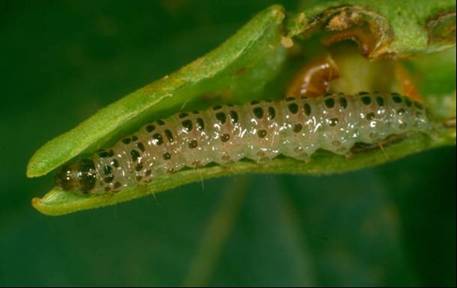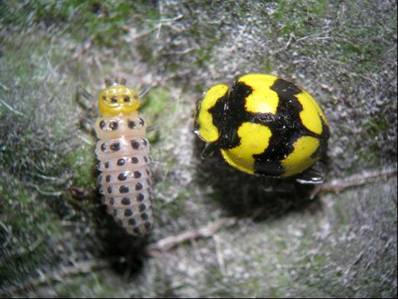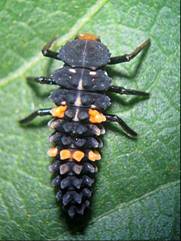Large numbers of different spotted larvae have recently been observed in many mungbean crops. The spotted larvae of the bean pod borer remains a significant pest of mungbeans yet the spotted fungus eating ladybird larvae poses no threat to crops.
In recent years, significant populations of bean podborer larvae (Maruca vitrata) have been reported in crops as far west as Surat. This is a considerable distance west of their normal range which is in coastal and sub coastal regions, with occasional incursions onto the Darling Downs.
Large bean pod borer
As a rule, pod borer activity is much higher in wetter seasons, with populations in excess of 100 per square metre recorded in the summer of 2011/12. Despite a slow start to the wet season of 2012/13, podborers are now present in many mungbean crops, albeit in not as high numbers as last year and not as far inland.
The cool and rainy weather also favours the larvae of the fungus-eating ladybird Illeis galbula. Recent weather conditions favour the growth of fungi that they (adults and larvae) feed on, including sooty mould and powdery mildew.
Fungus eating ladybird larvae and adult
Fungus eating larvae are readily differentiated from bean podborer larvae by the six rows of black spots, a bright yellow head, and legs that splay out sideways from the body. Podborer larvae have 4 rows (2 main rows) of black spots, a black or brown head, and legs held under the body. Fungus-eating ladybirds are found on the leaves, whereas podborer larvae feed in flowers and pods
Fungus-eating ladybird larvae can easily be distinguished from predatory ladybirds, as their basal colour is white, whereas predatory ladybird larvae are usually black with orange bands. The adults are instantly recognizable as they are bright yellow with black markings, whereas the predatory ladybird adults are orange with black markings.
Predatory ladybird larvae
Note that an emergency use permit (PER 14020 – valid to 31 May 2013) has been secured for the use of Altacor (chlorantraniliprole) against bean podborer in mungbeans, at the rate of 70 g/100L plus a non-ionic surfactant at 125g ai/100L.
This product gives good residual caterpillar control but has no impact on predatory or fungus-eating ladybirds, or any other beneficial insects.
Article by Hugh Brier
Images by Joe Wessels



